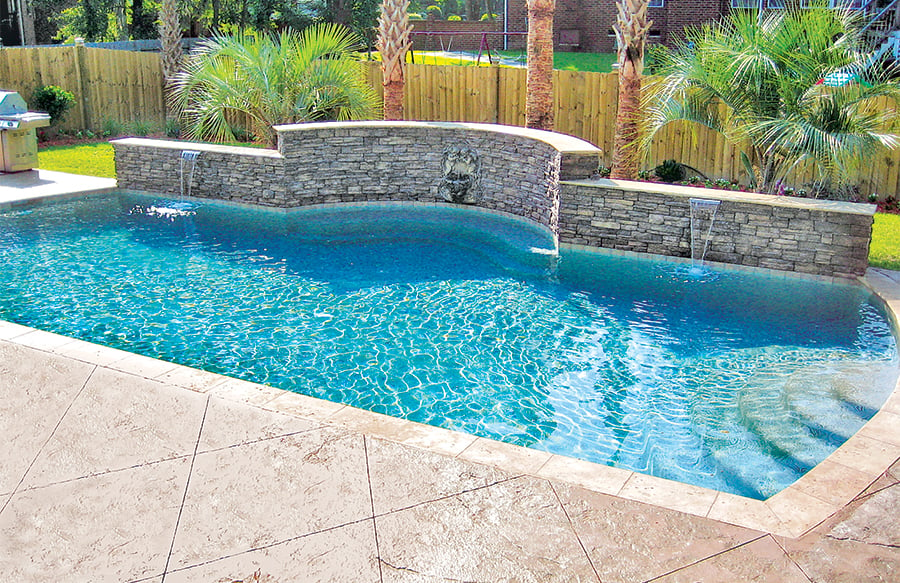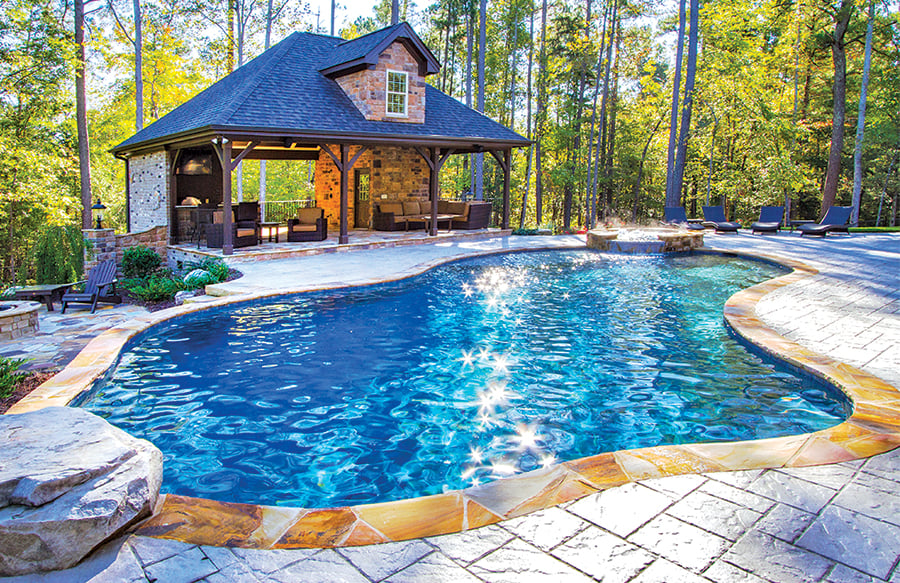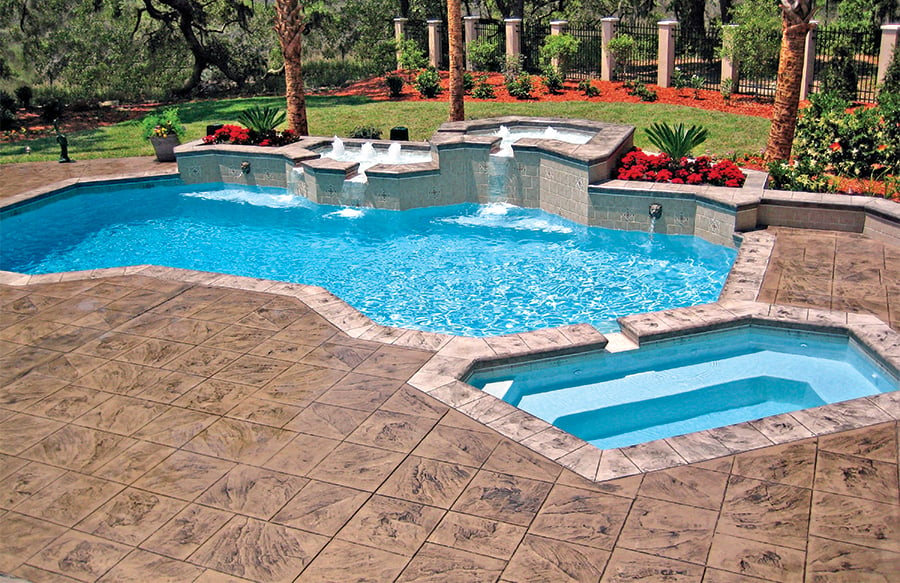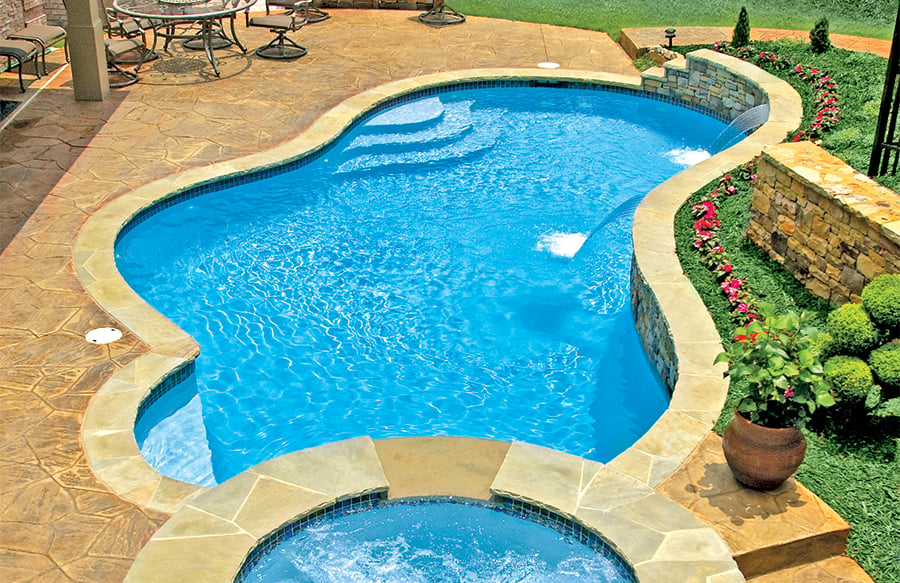— Customize your patio with stylish techniques for color and texture

High durability and versatility for customizing color, pattern, and style make decorative concrete decking one of the most popular choices for the patio material around swimming pools.
Many design considerations come into play when planning a concrete pool deck. Among them: the size/amount of deck; its shape around the pool and outdoor space; the kinds of activities for which the deck will be used; the kind of furniture and accessories it will need to accommodate; and what features—from steps to outdoor kitchens—will be integrated.
Of course, you will want your new deck to visually and functionally complement your pool, your home’s exterior and the landscaping.
Before selecting the style and color of your pool deck, you might want to read this article on planning a new pool deck or replacement.
Now, with your concrete deck plan in mind, we will take a look at some popular decorative styles available including options for beautiful colored and textured finishes.
 A favorite approach for stamping a concrete pool deck is with a pattern that resembles paver stones.
A favorite approach for stamping a concrete pool deck is with a pattern that resembles paver stones.
Pool decks fall into two main categories: poured concrete and manufactured or quarried pavers. Both provide great style and durability. In addition to poured concrete’s reasonable cost, its versatility for customizing color, pattern, and style make it one of the most popular choices for the patio material around swimming pools.
Concrete is a mixture of Portland cement (which acts as a binder), sand, water, and gravel. It may also contain additives to give the concrete certain properties and fly ash to improve workability.
Using various tools and techniques while the material is wet, workers create a finish that’s either smooth, patterned, or textured. Let’s take a look at some popular options for creating a distinctive finish.
Broom finish
The most common and economical way to treat a concrete deck is what’s known as a broom finish. As the poured concrete surface sets, crews use strong-bristled, horse-hair brooms to brush across the top and create a slightly textured surface. This is the least that should be done to give a pool deck enough traction for safety.
You may want an understated broom finish for your deck. However, if you prefer more dimension and texture, speak to your decking contractor to see if they can run the broom in a few different directions to create diamond or scalloped shapes.
Coloring concrete deck
Whether smooth or textured, you can punch up the style of any finish by adding color to the concrete.
In the past, applying an outdoor, waterproof paint was a common way to color a concrete deck. Crews painted the deck after the material set.
However, wear and tear from high foot traffic will cause paint to fade, chip and wear away. Paint can also be slippery. For these reasons, paint is no longer recommended for use around concrete pool decks.

Featuring a combination of techniques, this base-colored concrete also includes a stamped finish.
Today, a better approach is to color concrete. Crews add color powders to the concrete mix while it’s still wet.
Blending and “impregnating” color into the mix before the deck is poured distributes it evenly, and the final result is a more uniform coloring.
Based on cost and best practices in your local area, your contractor will advise if this is a good approach.
With this technique, your deck color will likely end up being a unique blend of the added color and the concrete’s natural shade of gray.
Color charts can give homeowners a reasonable idea of the range of the color you can expect. However, keep in mind that no two decks with the same added color will look exactly alike.
Be sure to consult with your pool builder or deck contractor about coloring . They will be able to recommend appropriate options based on the look you want to achieve, local building conditions, and regional factors like annual temperature change where you live.
Salt Finish
You can also have a variation on a broom finish deck. If you would like to add more texture—as well as skid resistance—to your deck’s appearance, a salt finish might be for you.
This easy-to-apply (but hard-to-get-right) method works on plain or colored concrete. Crews apply it immediately after broom finishing while the deck is still wet.
The process involves evenly spreading coarse rock salt over the freshly poured concrete. Then, crews use rollers to press the pea-size chunks of salt into the surface.
After the concrete sets, crews use a power washer to spray away the salt—which leaves behind a speckled pattern of shallow indentations.
Note: Typically, a salt finish is best suited for more temperate regions. In areas where the temperature varies a great deal from season to season, this indented pattern could lead to cracking when the mercury dips below freezing.
Stamped concrete
“Stamping” is another popular method for producing decorative concrete deck.
Using pattern molds, your builder can stamp impressions into the wet concrete to make its surface visually mimic the shape of different materials, such as tile, brick, or stone. And like the genuine material, the stamp forms can take the shape of a large variety of patterns.

In this outdoor dining area, the patio deck features concrete stamped with a ”creek-bottom” pattern.
Because so many stamp and color options are available, selecting one may be difficult. One approach is to select a color that matches or complements colors used on your home’s exterior or in your landscaping. Also, keep in mind the interior color of your pool and tile, and consider how that will look with the deck color.
The texture and pattern of the stamp should also complement the pool coping and overall poolscape. For example, rock-like patterns typically work best with natural freeform pools. A geometric pool with angles might look better with a brick-like treatment.
There are few hard-and-fast design rules, and sometimes the best effects come from breaking them.
Once crews stamp your deck, they can seal the surface to make it waterproof. If they use a sealant with special additives, it can add traction as well, making it skid-resistant.
It’s important that the surface of a stamped concrete deck be virtually flat; if the pattern outlines are too deep, the deck may not be patio-furniture friendly.
Stenciling
As an alternative to stamping, stenciling is a decorative design technique that allows for a great deal of precision.
The process uses custom-made, disposable paper stencils to create unique patterns atop the fresh concrete.
For example, stencils—along with applying the appropriate selection of color to the concrete mix—can replicate the look of individually mortared bricks or natural stones.
Stenciling is an intricate process using time and labor, so it costs more to do. Consider your budget. However, this approach will usually produce an attractive appearance for less than using genuine brick or stone.
Exposed aggregate
This option begins with introducing tiny colored stones and pebbles into the wet concrete mix. Deck crews then use power sprayers to wash the smooth, cement-rich surface away to expose the aggregate, creating a pleasing aesthetic.
Hand-seeding the concrete with colored aggregate is an option that may cost more, but many homeowners believe the lovely effect is worth the expense.
The aggregate stones and pebbles used in deck concrete come in various colors and sizes ranging from approximately three-eighths to three-quarters of an inch.
The stones and pebbles also come with either raw or machine-polished exteriors. Adding polished ones—versus raw ones—will produce a better, more comfortable deck for walking around on with bare feet. For being gentle on the feet, experts also suggest using small stones that are less than one-half-inch in diameter.
Coatings
Another option for concrete pool decks is a decorative coating. These blends can be clear, opaque, or translucent in a wide array of colors.
In addition to coloring and texturing the concrete, many coatings come with performance benefits. They can be waterproof, heat- and slip-resistant. Some even provide an extra barrier to algae and mildew growth.
Contractors trowel the coating mix over hardened concrete to achieve a highly uniform, consistent result. These coatings are available from a number of manufacturers. One is Sundek®, which consists of mixtures of modified acrylic resin. Another is Kool Deck®—which is made of a cement-based material.

A large square pattern completes this decorative concrete deck topped with an acrylic coating.
Another kind of decorative coating to consider is a polymer-modified overlay. After the concrete sets, crews spray this material in layers over its surface. One manufacturer of this deck coating is Spray-Deck®. It’s an example of an overlay system that offers the same performance benefits as acrylic coatings.
In some cases, contractors can combine a coating with the stenciling technique to create a pattern or precisely even gaps that resembles grout lines.
No matter the coating you choose, look for an installer with experience. Many have factory training and certification that can provide added assurance of their expertise.
Poured concrete pool decks offer creative opportunities
Concrete is an affordable, flexible material for creating the look and style that’s right for you and decorative concrete provides ample opportunities for design creativity for your pool patio area.
You can enhance poured concrete with quality coloring techniques. Decks can also gain distinctive style with textural touches, including broom or salt finishing, stamping, stenciling and a myriad of coating options.
Whatever style you opt for, your decorative pool deck will serve as the beautiful foundation for a backyard resort.
You now have the knowledge to help select the decorative concrete deck that is right for you and your pool. Before getting your heart set on any single choice, be sure to discuss color and texture options with your deck contractor or pool builder. Local conditions may limit on what is available in your area and appropriate for your pool and region.

If you think of your pool as a work of art and the trees, lawn, and planters surrounding it as the frame, you should think of your pool’s deck as the matting: it is nearly invisible to the viewer but goes a long way toward creating the overall effect. And it looks a lot better when done by an experienced professional.




.jpg?width=1490&name=rock-waterfall-slide-pool%20(1).jpg)